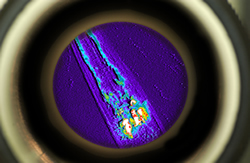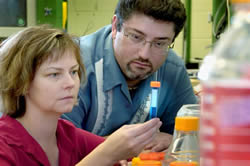Pipeline to Potential Parkinson’s Breakthrough Runs Through Campus Lab
By Chris Bryant

There’s an almost audible buzz emitting from a basement level laboratory in The University of Alabama’s Biology Building. The five graduate and 10 undergraduate students who work there, alongside Drs. Guy and Kim Caldwell, UA biology professors, are pumped. So too are their aforementioned faculty mentors.
The Caldwell Lab was recently selected by a world-renowned Parkinson’s disease expert as collaborators in a national five-phase plan, known as STOP PD. It is designed to identify one or more chemical compounds with potential to halt progression of the central nervous system disorder estimated to affect some one million Americans.
“I think the students involved in this project understand how fortunate they are to have an opportunity to make a difference, and they are eager to do so,” said Guy Caldwell, associate professor of biological sciences at UA and the state’s current Professor of the Year. “The students are working nights, weekends and in between classes. They are doing what it takes, and I think we’re going to get the job done.”
Getting the job done means finding promising leads in the effort to halt the disease’s progression. The California-based Parkinson’s Institute, led by Dr. J. William Langston, selected the Caldwell Lab to collaborate on Phase II of what it envisions as a five-phase plan, estimated to cost from $5-$6 million, to bring a new drug, which would stop Parkinson’s, to the clinical trial phase within the next two years.
Phase One has been funded by the Michael J. Fox Foundation for Parkinson’s Disease Research, and private donors and a private foundation have already committed significant funding toward the overall project.
Parkinson’s progresses very slowly at the beginning, Langston said. Subsequently, there’s a two-year period, on average, between the first symptoms and the initial diagnosis. “If we could intervene at that point and halt progression, we could give the majority of patients a near normal life,” Langston said.
“In the near term, this, I believe, is a more feasible strategy (than seeking an outright cure),” he said.
How could a potential breakthrough for Parkinson’s have ties to the Biology Building located off Tuscaloosa’s Hackberry Lane? To trace the connections, it helps to understand a bit about what scientists believe causes Parkinson’s.

Recently, scientists have learned that people with too many copies of the code for the protein alpha-synuclein within their DNA will contract Parkinson’s. To function correctly, proteins must fold properly within cells. One misfolding, as can occur when extra copies of the protein are present, can lead to others and, subsequently, to aggregation, or clumping, of proteins.
Aggregation of proteins can lead to neuron malfunction or cell death. In the case of Parkinson’s patients, it’s the neurons in the brain which normally synthesize dopamine that malfunction. This leads to the disease’s hallmark symptoms – rigid and tremoring limbs, difficulty in movement and impaired reflexes.
“Finding a molecule that inhibits that misfolding before it happens, or before it gets too bad, is the key,” Caldwell said.
In the project’s first phase, chemists at the University of California, Santa Cruz, will evaluate, in test-tube studies, the potential of some 20,000 to 30,000 molecules which, in drug form, could stop the clumping of alpha-synuclein. Between 200-300 of the most promising leads will be shared with the Caldwell lab for additional testing within the model system, C. elegans, a microscopic worm.
The worm’s simplicity – it contains only 302 neurons, in contrast to the 100 billion neurons located in the human brain alone – lends itself to manageable tracing of impacts on specific neurons. Despite its simplicity, the worm has key neurotransmitters, like dopamine. And more than 50 percent of all human hereditary diseases have been linked to genetic components also found in the worm, making it an appropriate model on which to study human diseases.
Researchers in the Caldwell Lab have previously taken a human Parkinson’s gene and transplanted it into the worms, along with a fluorescent jelly fish protein, both of which are “turned on” by neurons that produce dopamine. “We can use the fluorescent protein as a light bulb for seeing if the dopamine neurons are alive,” Caldwell said. “If the light goes out, they are dying.” Identifying molecules that, when fed to the worms, keep the light on provides a hint that the molecule may be neuroprotective.
From the hundreds of leads forwarded to the Caldwell lab, the UA researchers plan to identify the most promising compounds for further evaluation in rodents, at another lab.
Those, in turn, will be further narrowed for testing in primates and, later, in humans.
“He is providing a key link in this drug development pipeline,” Langston said of Caldwell. “If we didn’t have this medium throughput screening, it would take forever to get to the most promising compounds.”
One of the buzz terms at the National Institutes of Health is translational research. “The term translational research can be summed up as how do we get it to humans quicker,” Caldwell said. “Well, we’re lining up all the pieces of the puzzle to get it to humans quicker. At the end of this pipeline, after the rodents and primates, there are human patients at the Parkinson’s Institute, and other collaborating centers, who will be recruited for clinical trials.
“We can unequivocally say that the pipeline to halting Parkinson’s is running through Hackberry Lane,” Caldwell said. “And Alabama students and researchers in our lab, as we speak, could hold in their hands right now the potential molecule that represents a breakthrough.”
Further Reading
Contact
Cathy Andreen, Director of Media Relations, 205/348-8322, candreen@ur.ua.edu